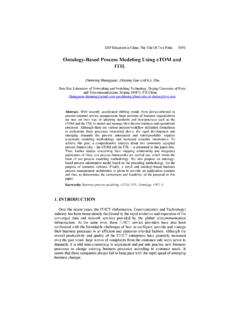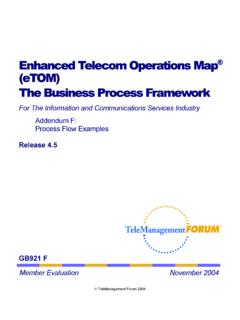Transcription of NGOSS- eTOM,SID and TAM
1 Course Description:Enhanced Telecom Operations Map (eTOM) is the TeleManagement Forum s industry standard business process framework used by telecommu-nications service providers and their course provides students with an introduction to the widely used etom framework , its benefi ts to service providers and their suppliers, and ways in which eTOM can be implemented in their en-vironment. The course addresses the relationship between eTOM and NGOSS (New Generation Op-erations Systems and Software), TeleManagement Forum s standard OSS/BSS development lifecycle framework , and the NGOSS elements including the SID (Shared Information and Data Model) and the TAM (Telecom Applications Map).Course Outline:1. What are eTOM and NGOSS?
2 Why are they needed?This initial module introduces the student to the Lean Operator vision and the role of New Genera-tion Operations Systems and Software (NGOSS) as an enabling set of frameworks. We also intro-duce each of the component frameworks (eTOM, SID, TNA, and TAM); we focus in particular on the role of the Enhanced Telecom Operations Map (eTOM) in standardizing the way in which service providers design their business processes. NGOSS What is it? Terminology The Lean Operator vision & strategy 4 components of NGOSS: eTOM, SID, TNA, TAM Who are some of the players?2. NGOSS Lifecycle & Methodology Concepts & Defi nitionsIn this section, we examine the NGOSS Lifecycle Methodology as an implementation tool.
3 In particu-lar, we explain the elements of the NGOSS Knowl-edge Base (eTOM, SID, TNA): Defi nitions Methodology Goals Explaining Technology Neutral Architecture (TNA) The NGOSS Knowledge Base The 4 views of NGOSS Lifecycle: business System Implementation Deployment Use Cases and Contracts in the NGOSS Lifecycle The SANRR Methodology: Scope, Analyze, Normalize, Rationalize, Overview and PrinciplesHaving reviewed the 4 views of NGOSS, we now begin to concentrate on the business view and introduce the student to the role of the Enhanced Telecom Operations Map (eTOM) in standardizing the way in which service providers design their business processes. eTOM - Origins and goals Terminology ETOM - The big picture4.
4 ETOM The business process FrameworkIn this section, we examine the various components of the etom framework . Starting from Levels 0 and 1 big picture , we drill down to sub-processes at lower levels of decomposition: Operationso Operations Support and Readiness ( OSR )o Fulfi llment, Assurance, and Billing ( FAB )o OPS Processes Levels 1 and 2 for OSR and FAB Strategy, Infrastructure, and Product ( SIP )o Strategy & Commito Infrastructure Lifecycle Managemento Product Lifecycle Management Enterprise process DecompositionIn this module we examine the process decomposi-tion technique and how it can be used to reveal fi ner process details at lower levels. The ultimate objective is to produce an enterprise view of process capabili-ties and functionality: process Decomposition A defi nition process Levels process Decomposition The approach.
5 process Flows and Interactions6. The Shared Information & Data Model (SID)Having addressed the business process require-ments in the business view, we now move to the Sys-tem view of NGOSS and discuss the Functional, Infor-mation and Data Model requirements to support the business processes mapped to eTOM. We describe the benefi ts of having a streamlined approach to infor-mation and data modeling and how the SID enables this streamlining by aligning with eTOM processes. SID Defi nition and goals The SID framework SID and eTOM alignment SID Key Entities SID in Real life : Industry Adoption7. The Telecom Applications Map (TAM)Whereby eTOM provides Service Providers a refer-ence framework for business processes, TAM pro-vides a reference framework for the applications.
6 This section defi nes the Applications framework describes how to execute this mapping effectively. TAM Defi nition and goals NGOSS and TAM TAM Domains TAM and eTOM A discussion8. eTOM Alignment with other ModelsIn this module we examine how the eTOM relates to other industry models such as TMN, ITIL, Rosetta-Net, and Six Sigma. One of our areas of focus is the alignment between eTOM and ITIL (IT Infrastructure Library) processes. We defi ne at a high level the ITIL framework and the processes related to Service Man-agement (Service Delivery and Service Support); we then describe the synergies between eTOM and ITIL and the alignment between their processes. ETOM linkage to NGOSS and the SID ETOM and ITU-T TMN ETOM & Six Sigma eTOM in a B2B context: Alignment with Roset-taNet clusters Mapping eTOM to ITIL9.
7 ETOM From Theory to PracticeHere we examine how you can bring the eTOM into your own environment. We also examine some of the work that is being done by various industry adopters of eTOM, from within the services provider community and from the vendor community. eTOM in a Greenfi eld environment Adapting eTOM to your infrastructure Sampling of eTOM Adopters and Case Studies10. A Real-Life Case StudyIn this section, we examine a real-life case study of a carrier s implementation of eTOM within its environment. We cover each of the steps taken to ensure successful implementa-tion: As-Is Analysis Mapping to eTOM Gap Analysis Enhancement & Optimization process Flows Decomposition business Rules Documentation11.
8 Summary & Document MapThis section summarizes the role of NGOSS and its various components (eTOM, SID, TNA, and TAM) in providing a set of frameworks for commonality in developing and maintaining streamlined solutions. We also bring the stu-dent up to speed on the latest NGOSS devel-opments currently taking WorkshopIn this 4-part workshop, the students work in teams, presenting their solutions to the class. The workshop takes into account the client s own environment, and deals with a real-life current issue(s). We begin by articulating the issue(s) at hand and identify the clients own relevant processes. Using the tools learned during the presentations, especially the SANRR methodology and process decom-position methods, the teams develop a use case, analyze the problem and potential solu-tion, map their processes to eTOM, develop process fl ows, and develop a contract for the Code: eTOMF Duration: 3 DaysService ManagementNGOSS- eTOM,SID and TAMP hone: : : NowThis training is delivered in partnership with PM-PARTNERS Group (A PMI Global Registered Education Provider)









